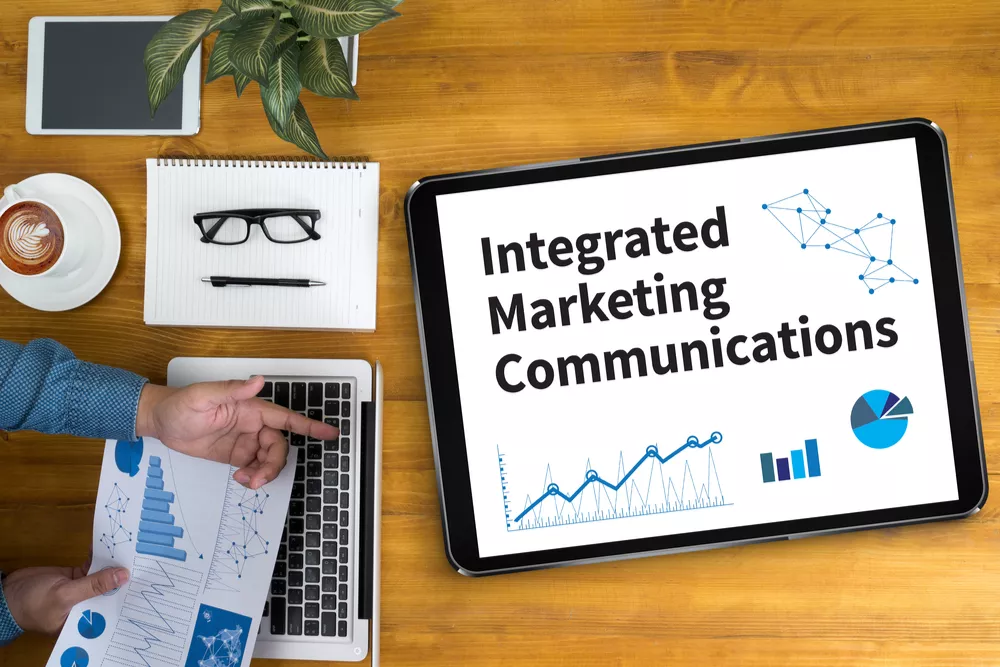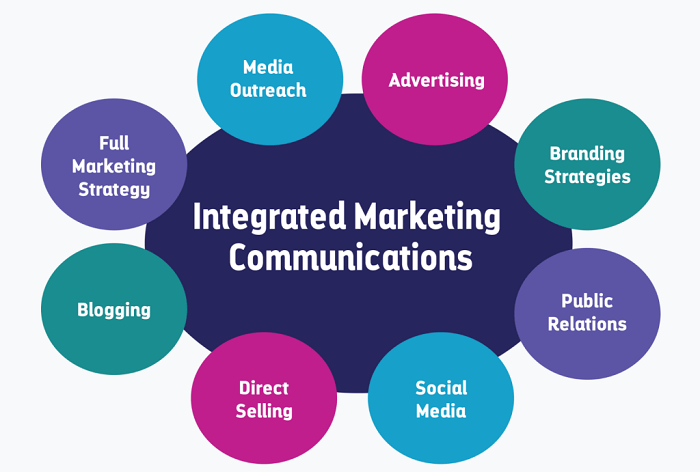Integrated Marketing Communications (IMC)
In the ever-changing landscape of marketing, successful businesses understand the need for an approach that transcends fragmented marketing efforts and delivers a unified brand experience to consumers. Enter Integrated Marketing Communications (IMC) – a strategic, synergistic, and customer-centric approach that has revolutionized the way businesses connect with their target audience. Fasten your seat belt as we embark on an enlightening journey to explore the essence of IMC and its profound significance in today’s dynamic marketing landscape.

What is Integrated Marketing Communications (IMC)?
At its core, IMC is a strategic and holistic approach that integrates various marketing communication channels to create a unified and seamless brand experience. It brings together advertising, public relations, digital marketing, social media, direct marketing, and other communication elements to deliver a consistent and cohesive message to the target audience. We will delve into the definition of IMC, unravelling its multifaceted nature and exploring how it has become an indispensable tool in modern marketing.
The importance of IMC in today’s marketing landscape cannot be overstated. With consumers being bombarded by messages from numerous sources, the need for a unified and consistent brand voice has become paramount. We will explore the benefits of adopting an IMC approach, including enhanced brand recognition, improved customer engagement, and increased brand loyalty. Additionally, we will discuss how IMC unifies marketing efforts, aligning all communication channels towards a shared marketing objective.
Evolution of Marketing and IMC
To understand the significance of IMC, it is crucial to explore the evolution of marketing and the challenges that traditional marketing methods present. We will delve into the limitations of fragmented marketing approaches, where disconnected messages often led to confusion among consumers.
As consumer behaviour evolved and technology reshaped the marketing landscape, IMC emerged as a response to these changing dynamics. We will trace the development of IMC as a strategic solution to the fragmented marketing landscape, bringing harmony and synergy to diverse marketing efforts. Furthermore, we will analyze how technology, particularly the rise of digital platforms and social media, has played a pivotal role in driving the evolution of IMC.
Throughout this chapter, we will also showcase the success stories of companies that have successfully implemented IMC strategies. These case studies will illustrate how embracing an integrated approach has propelled brands to new heights of success, resonating with their target audiences and driving remarkable business outcomes.
As we journey through the chapters ahead, we will delve deeper into the core principles and strategies of IMC, empowering marketers to harness its potential and navigate the complex marketing landscape with confidence and ingenuity. So, fasten your seatbelts as we embark on an enlightening exploration of Integrated Marketing Communications and its transformative impact on modern marketing practices.

2. Understanding the Components of IMC
Integrated Marketing Communications (IMC) is a powerful approach that combines various marketing channels to deliver a cohesive and unified message to the target audience. In this chapter, we will delve into the key components of IMC, exploring how each element contributes to a successful integrated marketing strategy.
2.1 Identifying Target Audience and Segmentation
Understanding and defining the target audience is fundamental to the success of any marketing campaign. In the realm of IMC, it becomes even more critical as it sets the foundation for crafting personalized and relevant messages that resonate with the intended consumers.
Importance of Defining Target Audience
- Precision Targeting: Identifying the specific demographics, behaviours, and preferences of the target audience allows marketers to tailor their messages accordingly. This precision targeting leads to higher engagement rates and conversion rates.
- Resource Optimization: By focusing efforts on the right audience, marketing budgets are optimized, ensuring that resources are not wasted on reaching irrelevant or disinterested individuals.
Market Segmentation and its Role in IMC
- Segmentation Strategies: Market segmentation involves dividing the target market into distinct groups based on common characteristics such as age, location, interests, and buying behaviour. This segmentation facilitates more targeted communication efforts.
- Personalization Opportunities: With well-defined segments, marketers can create personalized content that speaks directly to the unique needs and desires of each group. Personalization enhances customer experiences and fosters brand loyalty.
Techniques for Audience Research and Analysis
- Surveys and Questionnaires: Conducting surveys and questionnaires help gather valuable data about the target audience’s preferences, pain points, and buying behaviour.
- Data Analytics: Leveraging data analytics tools enable marketers to extract insights from customer interactions, enabling data-driven decision-making.
Personalization and its Impact on IMC Effectiveness
- Tailored Messaging: Personalization allows marketers to tailor messages to individual customers or segments, enhancing the relevance of marketing content.
- Enhanced Engagement: Personalized content leads to higher engagement levels, as customers are more likely to interact with messages that address their specific needs.

2.2. Brand Identity and Messaging
A strong brand identity forms the cornerstone of an effective IMC strategy. In this section, we explore the importance of crafting a compelling brand identity and ensuring consistent messaging across all marketing channels.
Crafting a Strong Brand Identity for IMC Success
- Brand Values and Mission: Defining the brand’s values and mission helps establish a clear and authentic brand identity that resonates with customers.
- Visual Branding: Creating a distinctive visual identity through logos, colours, and design elements helps customers recognize and connect with the brand.
Ensuring Consistent Brand Messaging Across All Channels
- Message Alignment: Consistency in messaging ensures that the brand’s core values and key messages remain the same across various marketing channels.
- Omnichannel Experience: A seamless and consistent brand experience across channels fosters brand recognition and trust.
Storytelling through Branding and its Influence on Consumer Perception
- The Power of Storytelling: Storytelling humanizes the brand and creates an emotional connection with the audience, making the brand more memorable.
- Brand Story Integration: Integrating the brand story into IMC efforts reinforces the brand’s narrative and helps differentiate it from competitors.
Case Studies of Brands with Compelling Brand Identities
- Case Study 1: [Brand] – Examining how [Brand] developed a compelling brand identity that resonates with its target audience.
- Case Study 2: [Brand] – Analyzing how [Brand] successfully communicated its brand story across various marketing channels.
In the next chapter, we will explore the role of Public Relations (PR) in Integrated Marketing Communications (IMC), shedding light on its significance in the overall marketing mix.

3. Creating a Unified Digital Marketing Strategy
In today’s digital age, a robust digital marketing strategy is indispensable for any successful Integrated Marketing Communications (IMC) campaign. In this chapter, we explore the key elements of creating a unified digital marketing strategy that seamlessly integrates with the overall IMC approach.
3.1. Leveraging Content Marketing in IMC
Content marketing plays a pivotal role in IMC, serving as the backbone of a cohesive and engaging customer experience. It involves creating valuable, relevant, and consistent content to attract and retain the target audience. Let’s dive into how content marketing complements IMC efforts and the strategies involved in its successful implementation.
How Content Marketing Complements IMC Efforts
- Building Brand Authority: Through content marketing, brands can position themselves as industry thought leaders and gain the trust of their audience.
- Enhancing Customer Journey: Content tailored to different stages of the customer journey provides valuable information at every touchpoint, guiding potential customers towards conversion.
Content Planning and Creation for Various Stages of the Customer Journey
- Awareness Stage: Content at this stage should focus on creating awareness about the brand, its products, and solutions. Blog posts, infographics, and explainer videos are effective content formats.
- Consideration Stage: Customers in the consideration stage seek more in-depth information. Whitepapers, case studies, and webinars help address their specific needs and pain points.
Integrating Content Across Platforms and Channels
- Consistent Messaging: Regardless of the platform, the content should maintain consistent messaging, reflecting the brand’s identity and values.
- Omnichannel Experience: An omnichannel approach ensures that customers have a seamless experience, whether they interact with the brand through a website, social media, or email.
Evaluating Content Performance and Optimizing Strategies
- Data-Driven Analysis: Analyzing content performance metrics, such as engagement rates, click-through rates, and conversions, helps marketers identify successful content and areas for improvement.
- A/B Testing: Conducting A/B tests with different content variations allows marketers to determine which messages resonate best with their audience.

3.2. Harnessing the Power of Social Media in IMC
Social media has revolutionized the way brands connect with their audience and plays a vital role in an effective IMC strategy. Let’s explore how to harness the power of social media for IMC success.
The Impact of Social Media on IMC Success
- Wider Reach: Social media platforms enable brands to reach a vast and diverse audience, fostering brand visibility and recognition.
- Real-Time Engagement: Social media facilitates direct and real-time interaction with customers, providing immediate feedback and addressing concerns.
Strategies for Effective Social Media Integration
- Consistent Branding: Maintaining consistent branding elements across social media profiles ensures brand recognition.
- Content Diversification: Tailoring content for each platform, such as short and visually appealing posts for Instagram and longer-form articles for LinkedIn, enhances engagement.
Engaging and Interacting with the Audience on Social Platforms
- Two-Way Communication: Encouraging dialogue with the audience through comments, messages, and polls fosters a sense of community and brand loyalty.
- User-Generated Content: Sharing user-generated content amplifies brand advocacy and authenticity.
Tools and Metrics to Measure Social Media ROI in IMC
- Social Media Analytics Tools: Utilizing analytics tools allows marketers to track key performance indicators (KPIs) like reach, engagement, and conversions.
- ROI Calculation: Measuring the return on investment (ROI) of social media efforts helps determine the effectiveness of the social media component in the overall IMC strategy.

3.3. Integrating SEO and SEM into the IMC Mix
Search Engine Optimization (SEO) and Search Engine Marketing (SEM) are integral to driving online visibility and traffic. In this section, we explore how integrating SEO and SEM enhances the reach and impact of IMC campaigns.
The Role of Search Engine Optimization (SEO) in IMC
- Organic Visibility: SEO improves a brand’s organic visibility on search engine results pages, driving targeted traffic to the website.
- Keyword Research and Targeting for IMC Campaigns
- On-Page and Off-Page Optimization: Implementing both on-page and off-page SEO tactics ensures the website’s authority and relevance.
Incorporating Search Engine Marketing (SEM) for Enhanced Reach
- Paid Advertising: SEM complements organic efforts by placing targeted ads on search engine results pages.
- Ad Extensions: Utilizing ad extensions, such as site links and callouts, provides additional information and enhances ad visibility.
Tracking and Analyzing SEO and SEM Performance
- Web Analytics: Leveraging web analytics tools help assess the performance of SEO and SEM campaigns.
- Conversion Tracking: Implementing conversion tracking allows marketers to measure the success of specific goals, such as form submissions or product purchases.
In the next chapter, we delve into the role of traditional advertising in IMC, exploring the significance of traditional channels in the digital age and strategies for measuring traditional advertising ROI.
4. The Role of Traditional Advertising in IMC
As technology continues to shape the marketing landscape, traditional advertising remains a vital component of an effective Integrated Marketing Communications (IMC) strategy. In this chapter, we explore the enduring significance of traditional advertising channels and how they can be synergized with digital efforts for maximum impact.
4.1. Understanding Traditional Advertising Channels
Overview of Traditional Advertising Mediums
Traditional advertising encompasses a diverse range of mediums, each offering unique benefits and targeting specific audiences. Some key traditional channels include:
- Television: Television advertising reaches a wide audience and allows for storytelling through visuals and audio.
- Radio: Radio ads can be highly localized and have the advantage of being a companion to listeners during their daily routines.
- Print: Print advertising includes newspapers, magazines, brochures, and posters, providing tangible and enduring messages.
- Outdoor: Billboards and signage offer wide visibility and serve as eye-catching reminders to a broad audience.
Evaluating the Relevance of Traditional Channels in the Digital Age
Although digital marketing has gained significant traction, traditional advertising still holds value for several reasons:
- Wide Reach: Traditional channels can effectively reach audiences who may not be as digitally engaged.
- Brand Awareness: Television and outdoor advertising remain potent tools for building brand awareness.
- Targeting Specific Demographics: Local newspapers and radio stations cater to specific regional or niche markets.
Creating Synergy Between Traditional and Digital Marketing Efforts
To maximize the impact of an IMC campaign, a unified approach that blends traditional and digital marketing efforts is crucial:
- Consistent Brand Messaging: Ensuring that brand messaging remains consistent across all channels reinforces the brand identity.
- Call-to-Action (CTA) Integration: Integrating digital CTAs in traditional ads drives traffic to online platforms for further engagement.
4.2. Measuring and Analyzing Traditional Advertising ROI
While traditional advertising offers many advantages, measuring its return on investment (ROI) has historically been challenging. In this section, we explore key performance indicators (KPIs) and tools for analyzing the effectiveness of traditional advertising efforts.
Challenges in Measuring Traditional Advertising Impact
- Attribution: Determining the exact impact of a traditional ad on conversions can be complex, as customers may engage through other channels before converting.
- Offline-to-Online Conversion Tracking: Connecting offline advertising efforts to online actions requires sophisticated tracking methods.
Key Performance Indicators (KPIs) for Traditional Advertising in IMC
- Brand Recall and Recognition: Surveys and studies can gauge the audience’s ability to recall and recognize the brand after exposure to traditional ads.
- Website Traffic: Tracking website traffic following the release of a traditional ad provides insights into its impact on online engagement.
Tools and Methods for Analyzing Traditional Advertising Effectiveness
- Call Tracking: Utilizing unique phone numbers in different ads allows businesses to measure the volume of calls generated by specific campaigns.
- Coupon Codes: Assigning unique coupon codes to different traditional ads helps attribute sales to specific channels.
In the next chapter, we explore the significance of data analytics in IMC, uncovering the role of data-driven decision-making in crafting successful marketing strategies.
5. IMC and Data Analytics
In today’s data-driven marketing landscape, the significance of data analytics in Integrated Marketing Communications (IMC) cannot be overstated. In this chapter, we delve into the role of data analytics in IMC decision-making and how it empowers businesses to optimize their marketing strategies for better customer engagement and conversions.
5.1. The Significance of Data Analytics in IMC
Understanding the Role of Data in IMC Decision-Making
Data serves as the foundation for informed marketing decisions in an IMC strategy. By collecting and analyzing customer data, businesses gain valuable insights into consumer behaviour, preferences, and needs.
Collecting and Analyzing Customer Data for Targeted Marketing
To achieve effective IMC, businesses must collect and analyze customer data from various touchpoints, such as:
- Website Analytics: Analyzing website traffic, user behaviour, and conversion rates.
- Social Media Insights: Gaining valuable data from social media platforms, including engagement metrics and sentiment analysis.
- Email Marketing Data: Tracking email open rates, click-through rates, and customer responses.
Leveraging Data Insights to Optimize IMC Strategies
By leveraging data insights, businesses can:
- Personalize Marketing Content: Tailoring marketing messages to individual customer preferences.
- Identify High-Performing Channels: Determining the most effective marketing channels for specific audience segments.
- Improve Customer Journey: Understanding customer touchpoints and enhancing the overall customer experience.
5.2. Privacy and Ethical Considerations in IMC Data Analytics
Addressing Privacy Concerns in Data Collection and Usage
While data analytics offers tremendous benefits, it also raises privacy concerns. Businesses must take proactive measures to protect customer data and adhere to data protection regulations.
- Data Security: Implementing robust data security measures to prevent unauthorized access or data breaches.
- Transparency: Clearly communicating data collection and usage practices to customers.
Ethical Guidelines for Data-Driven IMC Practices
Ethical considerations are paramount when using customer data:
- Consent: Obtaining explicit consent from customers before collecting their data.
- Anonymization: Anonymizing personal data to protect customer identities.
- Data Deletion: Providing customers with the option to delete their data upon request.
Building Trust with Consumers through Responsible Data Handling
Responsible data handling fosters trust between businesses and consumers:
- Honesty and Integrity: Being transparent about data practices builds credibility.
- Data Stewardship: Demonstrating responsible data management reinforces brand reputation.
In the next chapter, we delve into compelling case studies of successful IMC campaigns by notable brands, uncovering the strategies that led to their triumph in the competitive market.
6. Best Practices for Implementing IMC
Key Takeaways from Successful IMC Campaigns
Drawing insights from the case studies, we distil key takeaways that can guide businesses in their IMC endeavours:
- Consistent Branding: Maintain consistent brand identity and messaging across all marketing touchpoints for a unified customer experience.
- Embrace Innovation: Embrace technological advancements and new marketing trends to stay relevant and ahead of the competition.
- Customer-Centric Approach: Prioritize understanding your target audience’s needs and preferences to tailor campaigns that truly connect with them.
Tips for Overcoming Common Challenges in IMC Adoption
Implementing IMC can present challenges, but these tips can help businesses navigate potential obstacles:
- Internal Alignment: Ensure that all teams within the organization are aligned with the IMC strategy and its objectives.
- Data Integration: Invest in tools and technologies that facilitate the seamless integration of customer data from different channels.
- Resource Allocation: Strategically allocate resources to different marketing channels based on their performance and impact on ROI.
Strategies for Continuous Improvement in IMC Efforts
In the dynamic marketing landscape, continuous improvement is essential. These strategies can help businesses stay agile and optimize their IMC efforts:
- Performance Analysis: Regularly analyze the performance of different marketing channels to identify areas for improvement.
- A/B Testing: Conduct A/B testing for marketing campaigns to assess the effectiveness of different strategies.
- Customer Feedback: Solicit and leverage customer feedback to refine and enhance the IMC strategy based on real insights.
With these best practices and case studies in mind, businesses can design and execute IMC campaigns that resonate with their audience, elevate their brand presence, and achieve remarkable marketing success.

FAQs (Frequently Asked Questions)
- What is the basic goal of integrated marketing communications (IMC)?
The primary goal of IMC is to create a seamless and unified brand experience for consumers across various marketing channels. By integrating different communication tools and strategies, IMC aims to deliver a consistent message that resonates with the target audience and strengthens brand identity.
- How does integrated marketing communications (IMC) differ from traditional marketing approaches?
Traditional marketing typically involves separate, disjointed campaigns for different channels, such as print, TV, and radio. In contrast, IMC takes a holistic approach, aligning all marketing efforts to work together synergistically. This ensures a cohesive brand message and improved customer engagement.
- What are some key benefits of adopting an integrated marketing communications (IMC) approach?
- Brand Consistency: IMC helps maintain a consistent brand identity and message across all marketing touchpoints, reinforcing brand recognition.
- Enhanced Customer Experience: A unified approach creates a seamless customer journey, improving the overall brand experience.
- Cost Efficiency: By optimizing marketing efforts and eliminating redundancies, IMC can lead to cost savings.
- Improved ROI: The synergy between different marketing channels often leads to higher returns on investment.
- How can data analytics contribute to the success of integrated marketing communications (IMC)?
Data analytics plays a crucial role in IMC decision-making by providing valuable insights into customer behaviour and preferences. By leveraging data, marketers can tailor their campaigns, personalize content, and optimize strategies to better resonate with the target audience.
- What are some common challenges businesses face when implementing integrated marketing communications (IMC)?
- Organizational Alignment: Ensuring all departments and stakeholders are aligned with the IMC strategy can be challenging.
- Data Integration: Consolidating data from various sources and platforms can pose technical difficulties.
- Measuring ROI: Measuring the impact of IMC on overall marketing performance requires comprehensive tracking and analysis.
- How can businesses overcome challenges in adopting integrated marketing communications (IMC)?
- Strong Leadership and Communication: Effective leadership and clear communication are essential for fostering collaboration and alignment within the organization.
- Investing in Technology: Investing in the right tools and technology can streamline data integration and analytics processes.
- Setting KPIs: Defining key performance indicators (KPIs) from the outset helps measure the success of IMC initiatives.
- What are some emerging trends in integrated marketing communications (IMC) strategies?
As the marketing landscape evolves, several trends are shaping the future of IMC:
- Influencer Marketing: Collaborating with influencers to amplify brand messages and reach niche audiences.
- Voice Search Optimization: Optimizing content for voice search to cater to the growing use of virtual assistants.
- Sustainability and Purpose-Driven Marketing: Incorporating sustainable and socially responsible initiatives into IMC strategies to appeal to conscious consumers.
By embracing these trends, businesses can stay ahead of the curve and further enhance their IMC efforts.
In conclusion, integrated marketing communications (IMC) represents a powerful approach that unifies marketing efforts and delivers a cohesive brand experience. By leveraging data, technology, and creativity, businesses can harness the full potential of IMC to build stronger brands, engage their audiences, and drive marketing success.

Conclusion
In this final chapter, we conclude our exploration of Integrated Marketing Communications (IMC) and its significance in today’s dynamic marketing landscape. Throughout the article, we’ve delved into the core concepts, strategies, and best practices that make IMC a powerful approach for businesses aiming to achieve marketing excellence and brand success.
Integrated Marketing Communications (IMC) stands as a comprehensive and cohesive approach to marketing that seeks to harmonize all communication efforts across various channels. By aligning messaging, branding, and strategies, IMC creates a unified brand experience for consumers, fostering stronger connections and trust.
The Core Pillars of IMC
At its essence, IMC revolves around three essential pillars:
- Consistent Messaging: By ensuring a consistent brand message is relayed across all marketing channels, businesses can reinforce their brand identity and make a lasting impression on consumers.
- Customer-Centric Approach: IMC emphasizes the importance of understanding and targeting specific audience segments. This customer-centric focus ensures that marketing efforts resonate with the right people at the right time.
- Synergy Among Marketing Channels: The integration of various marketing channels, both digital and traditional, enables businesses to amplify their message and achieve a more significant impact.
The Future of IMC
As marketing continues to evolve in response to technology, consumer behavior, and industry trends, IMC is bound to undergo further transformations. Here are some predictions and emerging trends to watch for in the future of IMC:
Artificial Intelligence (AI) and Automation
AI-powered technologies are set to play a more prominent role in IMC, offering data-driven insights, personalization capabilities, and automated campaign optimization. These tools will streamline processes, enhance targeting accuracy, and drive more significant returns on investment.
Enhanced Data Privacy and Transparency
With increasing concerns about data privacy and ethical data practices, businesses will need to prioritize transparency in their data collection and usage. By adhering to strict ethical guidelines and building trust with consumers, brands can strengthen their reputation and gain a competitive edge.
Immersive Technologies
Virtual reality (VR) and augmented reality (AR) are expected to become more prevalent in IMC strategies, offering immersive brand experiences and interactive storytelling. Brands that leverage these technologies creatively will captivate audiences and drive engagement.
Purpose-Driven Marketing
Consumers are increasingly drawn to brands that align with their values and contribute positively to society. Purpose-driven marketing, centred around social and environmental causes, will play a crucial role in connecting with conscious consumers.
Final Thoughts
In conclusion, Integrated Marketing Communications (IMC) has emerged as a vital strategy for modern businesses seeking to thrive in the ever-evolving marketing landscape. By adopting IMC principles and leveraging technology, data, and creativity, brands can build lasting relationships with their target audience and achieve marketing success. As the industry progresses, staying agile and embracing new trends will be key to harnessing the full potential of IMC and maintaining a competitive edge.
Thank you for joining us on this journey through the world of IMC. We hope this article has equipped you with valuable insights and actionable strategies to take your marketing efforts to new heights. May your future IMC endeavours be marked by innovation, collaboration, and the relentless pursuit of excellence.

